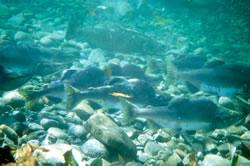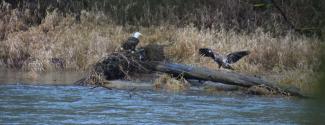Water, Air and Soil
Wild and Scenic Rivers
The Mt. Baker - Snoqualmie National Forest Wild and Scenic Rivers are managed to protect and enhance the free-flowing condition, water quality and outstanding values for which the rivers were designated, while providing for public recreation and resource uses that do not adversely impact or degrade those values.
The Mt. Baker Snoqualmie National Forest is home to two Wild and Scenic River Systems and seven designated segments. This includes the Skagit Wild and Scenic River System (the Skagit, Sauk, Suiattle, and Cascade Rivers, and Illabot Creek) and the Middle Fork Snoqualmie Wild and Scenic River System (the Middle Fork Snoqualmie and Pratt Rivers). These Wild and Scenic River Systems are managed to protect and enhance the free-flowing condition, water quality and outstanding values for which the river was designated, while providing for public recreation and resource uses that do not adversely impact or degrade those values.
Basics of the Wild & Scenic Rivers Act
The Wild and Scenic Act balances demand for hydropower, flood control, and irrigation with the desire to protect some of our most outstanding rivers in a natural and free-flowing state.
The Act’s underlying principles are:
- Keep designated rivers free flowing.
- Protect outstanding natural and cultural values.
- Allow existing uses of rivers to continue where they do not conflict with river protection.
- Build partnerships among landowners, river users, tribal nations, and all levels of government.
The Act may also:
- Encourage basin-wide management that crosses political boundaries.
- Promote public participation in developing goals for river protection.
- Offer technical assistance for river conservation.
- Improve understanding of river values and processes.
- Deepen the awareness, acceptance, and appreciation of river conservation.
River Information
Click on the tabs below to learn more about each of our designated Wild and Scenic Rivers.
Beginning high in the North Cascade Mountain Range, the Skagit Wild and Scenic River winds down steep slopes, through forested hillsides and wide, open valleys eventually reaching Puget Sound. The rivers of the Skagit System (Skagit, Sauk, Suiattle, Cascade, and Illabot Creek) flow through rugged wilderness, forestlands, rural communities, farmlands, and cities of the lower Skagit Valley. The rivers are vital to valley residents and visitors, as the ebb and flow of moving waters influence their lives.
The Skagit River and it's tributaries the Sauk, Suiattle, and Cascade rivers were designated in 1978, just 10 years after the original Wild and Scenic Rivers Act was signed into law. It wasn't until 35 years later that 14.3 miles of Illabot Creek were added to the National Wild and Scenic River System as a separate designation. This tributary had long been recognized as an important piece of the Skagit's network of habitat for endangered anadromous fish and other wildlife species that had been overlooked. With the designation of Illabot Creek, the Skagit Wild and Scenic River System became a unique example of how the Wild and Scenic Rivers Act can be used to safeguard entire systems for the protection of salmon and anadromous fish.
Recreation on the Skagit
Tall tales of adventure unfold as we look into the past along the Skagit Wild and Scenic River System. Ancient peoples followed the rivers in rhythm with the seasons, supported in their lifestyles by the riches of the natural world. A pioneering spirit drew others here in search of gold, fur and timber. Settlers embraced a way of life connected to the resources. This life continues today faced with new challenges and rewards. As you travel throughout the river system experience the unique character of each segment: the Skagit, Cascade, Sauk and Suiattle. Each river has its own complex communities, resources, histories and people to discover.
WHAT TO DO
Whether you want to shoot the rapids on a whitewater rafting adventure or leisurely paddle a canoe in serene waters, the Skagit Wild and Scenic River System provides some of the most outstanding boating opportunities in the Pacific Northwest. The four rivers offer a range of conditions and challenges for the novice as well as the more experienced river user. A number of guides provide opportunities throughout the year to enjoy the river system.
Attractive campsites, easily accessible by water or land, are located along the rivers. Hiking trails lead into forest and mountain settings of unsurpassed beauty. Day use picnic areas and viewpoints along picturesque travel routes offer opportunities to interact with this extraordinary place. Summary of recreation sites
Wildlife abounds within the watersheds. Birdwatchers flock to the Skagit River during winter months when one of the largest populations of bald eagles in the lower 48 states can be found feeding on the salmon runs. Hunting and fishing are regulated by the Washington State Department of Fish and Wildlife. Common species to be found along the river system are deer, black bear, elk, waterfowl, salmon and trout.
SEASONS OF USE
Weather in the Pacific Northwest can change rapidly any time of the year. Summer temperatures average around 60-70 degrees F, winter temperatures average 30-40 degrees F. As temperatures cool during the fall and winter months, snow levels may come down to lower elevations, sometimes gracing the banks of the river system. Hiking and camping opportunities may be limited during the late fall and winter months.
The Middle Fork Snoqualmie River and its tributary, the Pratt River, are located within the Upper Snoqualmie River Basin of the Snohomish Watershed above Snoqualmie Falls. The river corridor provides diverse recreation opportunities and the low elevation of the valley, proximity to a major metropolitan area, and accessibility by paved roads stands out as exceptional in the region. The watershed supports wild runs of Coho, chinook, pink, chum and steelhead salmon and hosts a population of genetically diverse and wild resident cutthroat trout. Old river channels, beaver ponds, wetlands, small ponds, and other water bodies scattered throughout the river corridors provide herbaceous and woody browse and foraging for a variety of species, as well as insect prey for bats and birds, and open water foraging areas for aquatic-based wildlife.
Resources, PDFs, and Links
Documents
Middle Fork Snoqualmie and Pratt Wild and Scenic Rivers Comprehensive River Management Plan
Mt. Baker-Snoqualmie National Forest – September 2022
This is the guiding document for the management and protection the Middle Fork Snoqualmie and Pratt Wild & Scenic Rivers. This management plan was a collaborative effort among stakeholders to guide the protection of outstanding water quality, free-flowing condition, and fish, wildlife, and recreation values for future generations.
PDF Version to Download, 103 pages
Environmental Assessment for the Middle Fork Snoqualmie and Pratt Wild and Scenic Rivers Comprehensive River Management Plan
Snoqualmie Ranger District, Mt. Baker-Snoqualmie National Forest, King County, WA – September 2022
Prepared alongside the Comprehensive River Management Plan (CRMP).
PDF Version to Download, 73 pages
In addition to water quality and free-flowing condition, Wild and Scenic Rivers are designated for possessing one or more outstandingly remarkable values known as ORVs. The ORVs for the Skagit, Suak, Suiattle, and Cascade Rivers include fish, wildlife, and scenery. The ORVs for Illabot Creek similarly include fish and wildlife. Because this river was designated as a Wild and Scenic River, these remarkable values will be protected, preserved, and enjoyed by many for generations to come.
Fish

Fish is an outstandingly remarkable value for all segments of the Skagit & Illabot Creek Wild and Scenic River System.
Catching sight of wild fish swimming and spawning throughout these rivers is an invigorating experience. Each species depends on certain elements to support them in their struggle for survival. Woody debris in the streams and shady riverbanks help provide structure for good habitat. Clear, cool waters running over gravels help keep spawning beds alive and ensure hatching of the next generation.
Distinctive runs of chinook, pink, coho and sockeye salmon share the rivers with winter chum, favorite food of the bald eagle. Wild steelhead and other sea-going trout also live in the rivers along with resident trout.
Wildlife

Wildlife is an outstandingly remarkable value for all segments on the Skagit & Illabot Creek Wild and Scenic River System.
A dramatic event unfolds each year as spawning salmon return to the rivers followed by hundreds of hungry bald eagles. As salmon reach the end of their life cycle, their rotting carcasses are left behind as food for the eagles and as rich nutrients benefiting many inhabitants of the river and riparian forest lining the banks.
It’s common to see forest-dwelling black-tailed deer browse for nettles, huckleberries and other plants and shrubs. While visiting the upper reaches of the river system you may see black bear feeding on salmon along the sand bars or a beaver gathering sticks and mud for his home. Great blue herons live alongside ravens, crows, owls and osprey. Freshwater marshes are a haven for whistling and trumpeter swans.
Scenery

Scenery is an outstandingly remarkable value for the Skagit, Sauk, Suiattle, and Cascade segments of the Skagit & Illabot Creek Wild and Scenic River System.
Travel along the rivers offers a wide spectrum of spectacular scenery. Views of rural communities blend with long undeveloped stretches of river adding to the wild character. Water shimmers in quiet pools, flows gently across wide channels and cascades over wood and rock in steep, narrow stretches.
Standing on a riverbank in the spring you are greeted by a lush array of salmonberry, thimbleberry, vine maple, and alder trees growing along the shoreline. As the seasons pass, colorful leaves drift away exposing stark bare branches and fields of golden grass. As you look up, deep green forested slopes of fir and cedar blend into jagged peaks of rock and snow. Beyond the scenery, discover a complex relationship of plants and wildlife within the landscape, creating a rich tapestry of life.
In addition to water quality and free-flowing condition, Wild and Scenic Rivers are designated for possessing one or more outstandingly remarkable values known as ORVs. The ORVs for the Middle Fork Snoqualmie River include unique fish, abundant wildlife, and unparalleled recreation opportunities that represent the best this region has to offer. The ORVs for the Pratt River similarly include fish and wildlife. Because this river was designated as a Wild and Scenic River, these remarkable values will be protected, preserved, and enjoyed by many for generations to come.



